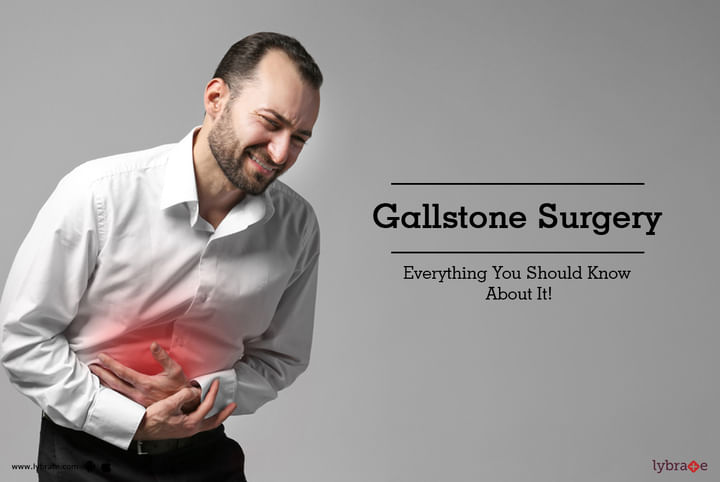Gallstone Surgery - Everything You Should Know About It!
The gallbladder is a pear-shaped organ that rests beneath the right side of the liver. Its main purpose is to collect and concentrate a digestive liquid (bile) produced by the liver. Bile is released from the gallbladder after eating, aiding digestion. Bile travels through narrow tubular channels (bile ducts) into the small intestine. Removal of the gallbladder is not associated with any impairment of digestion in most people.
What Causes Gallbladder Problems?
Gallbladder problems are usually caused by the presence of gallstones which are usually small and hard, consisting primarily of cholesterol and bile salts that form in the gallbladder or in the bile duct.
It is uncertain why some people form gallstones but risk factors include being female, prior pregnancy, age over 40 years and being overweight. Gallstones are also more common as you get older and some people may have a family history of gallstones.many fectres are thought to be associated with increased chances of gall stone formation but there is no definite known means to prevent gallstones.
These stones may block the flow of bile out of the gallbladder, causing it to swell and resulting in sharp abdominal pain, vomiting, indigestion and, occasionally, fever. If the gallstone blocks the common bile duct, jaundice (a yellowing of the skin) can occur.
Diagnosing
1) Ultrasound is most commonly used to find gallstones.
2) In a few more complex cases, other X-ray, CT scan or a gallbladder nuclear medicine scan may be used to evaluate gallbladder disease
Types of gallstones:
There are three main types of gallstones. They are
1.Mixed stones: They are made up of cholesterol and salts. They tend to develop in batches.
2.Cholesterol stones: Mainly made of cholesterol, which is crucial to many metabolic processes. They can grow large enough to block the bile ducts.
3.Pigment stones: The colour of bile is greenish-brown, due to some particular pigments.
These Gallstones don’t cause any problems in most cases. But prompt treatment is required if stones block ducts and cause life-threatening complications like infections and inflammation in the pancreas liver, gall bladder intestine and other organs nearby. This may require for removal of the gallbladder through a surgery, known as cholecystectomy, which further includes techniques such as laparoscopic (keyhole) cholecystectomy robotic or open surgery.
The gall bladder is a less vital organ, and the body can cope up normally even after its removal.
The procedure of surgery: Laparoscopic removed of the gall bladder is now the recommended standard of care/gold standard for gallstone disease.
1)The surgery involves the removal of gallbladder and gallstones through several incisions in the abdomen. In order to see clearly, the surgeon inflates the abdomen with air or carbon dioxide.
2)A lighted scope attached to a video camera is inserted into one incision near the belly button. The video monitor is used as a guide for inserting other surgical instruments into the other incisions to remove the gallbladder.
3)Intraoperative cholangiography is the X-ray procedure which shows the anatomy of bile ducts. This may be needed sometimes before the surgeon removes the gallbladder.
4)Bile flows from the liver through the common bile duct after the surgery into the small intestine. As the gallbladder has been removed, the gallbladder can no longer store bile between meals but this has little effect on digestion.
5)In case of open surgery, the surgeon reaches the gallbladder through a large, single incision in the abdominal wall, to perform the removal of gall bladder
4.FAQ: can gall stone treated with Medicines
The answer is both yes or no.
Yes: if gall stone are not symptomatic or have not started causing complications then certain medicines, diet and lifestyle changes can help in preventing complications
No: gall stone keep on dissolving and new stones keep on forming. there is no medicine proven to have resulted in complete dissolution of gallstones, also new stone from within months so there is actually no actual/definite benefit of removal of stones alone by medicines or even by surgery.
Are you a Candidate?
Although there are many advantages to laparoscopic gallbladder removal (cholecystectomy), the procedure may not be appropriate for some patients who have severe complicated gallbladder disease or previous upper abdominal surgery. A thorough medical evaluation by your personal physician, in consultation with a surgeon trained in laparoscopy, can determine if laparoscopic gallbladder removal (cholecystectomy) is an appropriate procedure for you.
Medical factors to consider before cholecystectomy:
The most important factor is the consideration of your medical history. This is because the pre-existing conditions influence decisions on surgery and anesthetic and information about any bad reactions or side effects from any medications would be helpful for surgery.
Laparoscopic Gallbladder Removal Surgery - What Should You Know?
What is Laparoscopic Gallbladder Removal Surgery (Laparoscopic Cholecystectomy)?
Gallbladder removal is one of the most commonly performed surgical procedures. Gallbladder removal surgery is usually performed with minimally invasive techniques and the medical name for this procedure is Laparoscopic Cholecystectomy or Laparoscopic Gallbladder Removal.
Gallstones do not go away on their own. Some can be temporarily managed by making dietary adjustments, such as reducing fat intake. This treatment has a low, short-term success rate. Symptoms will eventually continue unless the gallbladder is removed. Treatments to break up or dissolve gallstones are largely unsuccessful. Surgical removal of the gallbladder is the time-honored and safest treatment of gallbladder disease.
What are the Advantages of Performing Laparoscopic Gallbladder Removal?
1. Rather than a five to seven-inch incision, the operation requires only four small openings in the abdomen.
2. Patients usually have minimal post-operative pain.
3. Patients usually experience faster recovery than open gallbladder surgery patients.
4. Most patients go home the same day of the surgery and enjoy a quicker return to normal activities.
Complications after gallbladder surgery:
This surgery carries some degree of risk like any other surgery. Complications such as internal bleeding, infection, injury to nearby digestive organs, injury to the bile duct and injury to blood vessels.
Self-care after the surgery:
Taking rest is the most important thing after surgery. Personal hygiene special care to avoid wound infection. Avoid things such as heavy lifting and physical exertion. Early mobility brings early recovery and return to work. The usual recovery period after the surgery is one week. Bathing can be done with waterproof dressing.



+1.svg)
